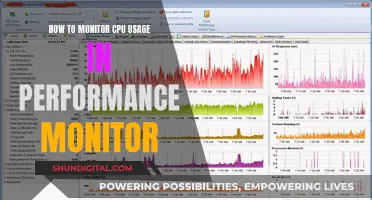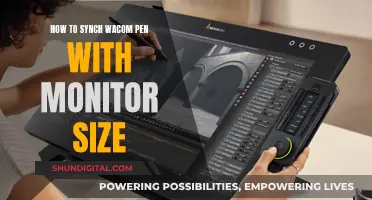
When it comes to choosing a monitor, there are several factors to consider. Firstly, you should determine the primary purpose of the monitor, such as gaming, professional use, or general use. The type of panel is also important, with Twisted Nematic (TN), In-Plane Switching (IPS), and Vertical Alignment (VA) being the most common options. TN panels offer fast response times and are typically used in gaming monitors, while IPS panels provide better colour accuracy and viewing angles, making them ideal for professional users. VA panels offer the best contrast and image depth, making them a good choice for those seeking immersive visuals.
Resolution is another key consideration when choosing a monitor. While 1080p used to be the standard, nowadays, you can find monitors with resolutions up to 8K. However, it's important to balance the resolution with the size of the monitor to ensure optimal pixel density. For example, a 24-inch monitor with a 1080p resolution or a 27-inch monitor with a 1440p resolution are good options for most users. If you're looking for a larger screen, a 32-inch monitor with a 4K resolution can provide a sharp and detailed image.
In addition to resolution, you should also consider the refresh rate and response time, especially if you're a gamer. A higher refresh rate, such as 144Hz or higher, can provide smoother gameplay and reduce input lag. A lower response time is also beneficial for gaming, as it reduces motion blur and ghosting.
Other features to look for in a monitor include built-in speakers, USB ports, adjustable stands, and HDR support. If you intend to use the monitor for video conferencing, you may also want to consider a model with a built-in webcam. Ultimately, the best monitor for you will depend on your specific needs and budget, so it's important to prioritize the features that are most important to you.
| Characteristics | Values |
|---|---|
| Resolution | 1080p, 1440p, 2K, 4K, 5K, 8K, FHD, QHD, UHD, WQHD |
| Size | 22", 24", 27", 32", 34", 40", 48", 57" |
| Aspect Ratio | 16:9, 16:10, 21:9, 32:9 |
| Ports | HDMI, DisplayPort, VGA, DVI, USB-C, USB-A |
| Refresh Rate | 60Hz, 75Hz, 120Hz, 144Hz, 165Hz, 240Hz, 360Hz, 500Hz |
| Response Time | 0.5ms, 2ms, 5ms, 6ms, 180ms |
| Panel Type | TN, IPS, VA, OLED, QD-OLED, QLED, Mini-LED |
| Features | Built-in webcam, speakers, adjustable stand,section, VESA mount, HDR, G-Sync, FreeSync, USB hub, curved, smart, touchscreen |
What You'll Learn

Resolution
The minimum resolution you need is 1920 x 1080 (also known as 1080p, Full HD (FHD) and HD). However, you'll get sharper images with Quad HD (QHD) and even sharper with 4K.
If you want reasonable clarity but want to save on cost or focus on other, more important features, 1080p is where it's at — as long as the monitor you’re buying isn’t extremely large. For 21-inch to 24-inch displays, 1080p is ideal.
1440p is the so-called sweet spot for gamers, as it offers a noticeable improvement in visuals over 1080p, but doesn’t overly tax your graphics card. Even if you’re not a gamer, you’ll enjoy the extra screen real estate.
4K is the resolution that the industry is most keen to drive consumers toward. With 3,840 x 2,160 pixels, it looks much more detailed than 1080p, and prices have come down substantially in the past few years. However, gamers will need a powerful graphics card to run a system at this resolution, and finding affordable monitors with full suites of frame-syncing support or high refresh rates is still difficult.
While 4K monitors are more common these days, you’ll still need to pay a pretty penny if you want to pair this resolution with high refresh rates and a high-quality panel. These displays are typically on the bigger side, meaning that you’ll need the desk space to support it and the ability to sit far enough away to not strain your eyes and your neck.
5K and 8K monitors are also available, but there's almost no reason to recommend buying one of these, both due to hardware limitations and cost.
Disassembling an ASUS Monitor: A Step-by-Step Guide
You may want to see also

Size
The size of a monitor is one of the most important factors to consider when buying one. The size of a monitor is measured diagonally, and the bigger the monitor, the higher the price.
For most shoppers, 24 inches is the baseline, as you can pick up a number of screens at that size for around $100, and they look fantastic at 1080p. If you want to go for something bigger, there are plenty of options. Monitors that stretch 27 inches diagonally are increasingly popular, and there are plenty of options beyond 30 inches that are affordable. If you want to go extreme, there are even monitors that get close to 50 inches.
While you’ll need to sit well back from those, there’s no denying that they look amazing. They give you the same screen real estate as multiple smaller monitors without a bezel dividing them down the middle. They tend to be rather expensive, though, and if you go really wide, you’ll struggle to find media that can display at close to its native resolution, leaving the picture either looking stretched or surrounded by black.
Anywhere between 24 and 32 inches is going to be perfectly fine for most users, and these tend to be the sizes that PC gamers tend to gravitate toward. They let you make the most of modern resolutions and color clarity, and they also fit a couple of open webpages at the same time without needing to use two monitors, which is handy for many professionals. They don’t tend to be too expensive at that size, either, unless you opt for the top-end models. Some of the top 32-inch gaming monitors can get pretty pricey.
OSD Button on ASUS Monitor: Where is it?
You may want to see also

Refresh rates
Refresh rate is the number of times your monitor updates with new information per second, measured in hertz (Hz). A higher refresh rate means better, smoother, and less choppy images. This is especially important for gamers, who will want a monitor with a refresh rate of at least 75Hz (most monitors designed for gaming offer at least 120Hz), combined with the lowest response time you can find. If you're not gaming, a 60Hz refresh rate should do.
If you're a gamer, look for a monitor with a refresh rate of 144Hz or faster.
Transform Your LCD Monitor into a Smart TV
You may want to see also

Response times
Response time is the speed at which a monitor can change the colour of a pixel, measured in milliseconds. A faster response time will reduce motion blur and ghosting, which is a faint trail left on the screen from previous images.
The fastest response times are ideal for gaming, where the speed and intensity of gameplay require a monitor that can keep up. A response time of 5ms or less is recommended for gamers, and the fastest gaming monitors can have a response time of 0.5ms.
For professional multimedia use, such as photo and video editing, a response time of 5ms or less is also recommended to reduce motion blur and ghosting.
For general use, response time is not a big priority, but a longer response time may still cause motion blur when watching fast-paced videos.
University WiFi: Staff Privacy and Monitoring Concerns
You may want to see also

Panel tech
When it comes to panel technology, there are three major types used in today's PC monitors: twisted nematic (TN), vertical alignment (VA), and in-plane switching (IPS).
Twisted Nematic (TN) Panels
TN panels are the fastest but cheapest due to poorer image quality when viewing from a side angle. TN panels are known for being inexpensive to make and offer very quick pixel response times, which improves motion clarity. They are ideal for gamers seeking a fast refresh rate. However, TN panels have limitations in contrast and colour performance, making them unattractive for tasks requiring accurate colour reproduction, such as photo or video editing.
Vertical Alignment (VA) Panels
VA panels offer robust colours and have better contrast and darker black levels than TN panels, which improves overall image quality. They are a good choice for those seeking improved image quality for watching movies and TV shows. However, VA panels have more limited viewing angles than IPS panels, so the image quality can degrade if not viewed straight-on.
In-Plane Switching (IPS) Panels
IPS panels have slightly faster response times than VA panels and offer better colour accuracy. They provide bright and crisp images with good sharpness and great viewing angles. Modern IPS panels can support fast pixel response times and high refresh rates, making them a good choice for gamers. However, IPS panels have disappointing contrast and black levels, which can make them appear hazy when viewing dark images in a dark room. IPS panels are ideal for professional photographers and graphic designers.
Is Your Monitor VESA-Compatible? Check with These Easy Steps
You may want to see also
Frequently asked questions
There are three major types of LCD technologies used in today's PC monitors: twisted nematic (TN), in-plane switching (IPS), and vertical alignment (VA). TN panels are the fastest but cheapest, due to poorer image quality when viewing from a side angle. IPS panels have slightly faster response times and show colour better than VA panels, but VA panels have the best contrast out of all three panel types.
The key specifications to look for when buying a monitor are resolution, size, refresh rate, response time, and panel type.
The ideal monitor size depends on your requirements and the space you have available. For most people, a 24-inch monitor is a good baseline, but sizes of up to 32 inches are increasingly popular.
The ideal monitor resolution depends on the size of the monitor. For a 21-inch to 24-inch display, 1080p is ideal. For larger monitors, 2,560 x 1,440 resolution (also known as Quad HD or QHD) at the least is recommended, and 4K (3,840 x 2,160 pixels) is ideal for viewing highly detailed images or looking at multiple pages side by side.
The ideal monitor refresh rate depends on your intended use. For gaming, a refresh rate of at least 75Hz is recommended, with competitive gamers preferring rates of 144Hz or more. For non-gaming use, a refresh rate of 60Hz is sufficient.







